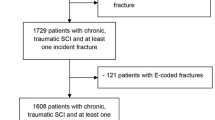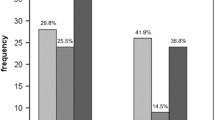Abstract
Introduction
The demographics of skeletal fractures found in patients presenting with a spinal cord injury to a modern level-one trauma center have not been reported.
Materials and methods
A retrospective review was performed of 1290 patients presenting between January 1997 and December 1999 with an acute vertebral fracture and spinal cord or cauda equina injury to determine the incidence, fracture type, and mechanism of all fractures of the extremities and pelvis.
Results
Overall, 128 (10% of 1290) of these patients sustained 203 associated skeletal fractures including 16 open fractures (8% of 203). The most common associated fractures involved the radius, tibia, femur, humerus, fibula, and ulna. Some 48% of the injuries was due to motor vehicle accidents, 41% to falls, 6% to recreational injuries or assaults, and 5% to gunshot wounds. Twenty-four patients (1.8% of 1290) were found to have more than one vertebral fracture and sustained a high rate of associated fractures (42 fractures), averaging 1.8 fractures per patient.
Conclusion
This study underscores the frequent association between vertebral fractures and fractures of the appendicular skeleton and pelvis and reinforces the need to maintain a high index of suspicion when evaluating neurologically injured patients due to the potential for symptom masking of acute nonspinal fracture.




Similar content being viewed by others
References
Burney RE, Maio RF, Maynard F, Karunas R (1993) Incidence, characteristics, and outcome of spinal cord injury at trauma centers in North America. Arch Surg 128:596–599
Comarr AE, Hutchinson RH, Bors E (1962) Extremity fractures of patients with spinal cord injury. Am J Surg 103:732–739
Eichenholtz SN (1963) Management of long-bone fractures in paraplegic patients. J Bone Joint Surg Am 45:299–310
Fehlings MG, Tator CH (1999) An evidence-based review of decompressive surgery in acute spinal cord injury: rationale, indications, and timing based on experimental and clinical studies. J Neurosurg 91:1–11
McMaster WC, Stauffer ES (1975) The management of long bone fracture in the spinal cord injured patient. Clin Orthop 112:44–52
Nottage WM (1981) A review of long-bone fractures in patients with spinal cord injuries. Clin Orthop 155:65–70
Saboe LA, Reid DC, Davis KA, Warren SA, Grace MG (1991) Spine trauma and associated injuries. J Trauma 31:43–48
Silver JR, Morris WR, Otfinowski JS (1980) Associated injuries in patients with spinal injury. Injury 12:219–224
Stover SL, Fine PR (1986) Spinal cord injury: the facts and figures. University of Alabama, Birmingham
Stover SL, Whiteneck GG, DeLisa JA (1995) Spinal cord injury: clinical outcome from the model systems. Aspen, Gaithersburg
Author information
Authors and Affiliations
Corresponding author
Rights and permissions
About this article
Cite this article
Anderson, S.D., Anderson, D.G. & Vaccaro, A.R. Skeletal fracture demographics in spinal cord-injured patients. Arch Orthop Trauma Surg 124, 193–196 (2004). https://doi.org/10.1007/s00402-003-0605-x
Received:
Published:
Issue Date:
DOI: https://doi.org/10.1007/s00402-003-0605-x




